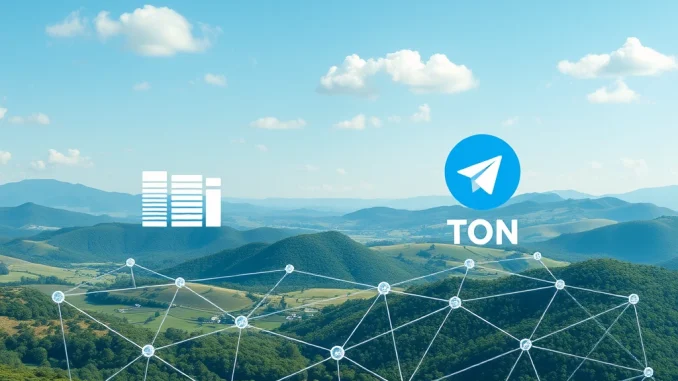
Get ready for a significant development in the world of digital finance. The **Tokenization** of real-world assets is picking up pace, and a major new initiative is set to bring half a billion dollars worth of **Telegram bonds** onto the blockchain. This move, spearheaded by the **Libre platform**, represents a concrete step towards integrating traditional finance with decentralized technology.
What is Happening with Telegram Bonds and TON Blockchain?
According to reports, Libre, a platform backed by notable financial players including Brevan Howard, Hamilton Lane, and Nomura’s Laser Digital, plans to tokenize $500 million worth of bonds issued by Telegram. These will be structured as the Telegram Bond Fund (TBF) and are slated to reside on the **TON blockchain** (The Open Network).
This isn’t just about putting bonds on a blockchain; it’s about creating a fund specifically designed to hold and manage these tokenized assets. Here’s a breakdown:
- **The Asset:** $500 million worth of Telegram’s outstanding bonds.
- **The Platform:** Libre, a tokenization service provider with strong institutional backing.
- **The Structure:** A dedicated fund, the Telegram Bond Fund (TBF).
- **The Network:** The TON blockchain, chosen as the underlying ledger.
This development highlights the increasing interest from institutional players in leveraging blockchain technology for traditional financial instruments. It’s a clear signal that the bridge between conventional markets and **digital assets** is being built, brick by brick.
Why Tokenize Telegram Bonds on TON Blockchain?
The decision to tokenize **Telegram bonds** and utilize the **TON blockchain** comes with potential benefits:
- **Increased Accessibility:** Tokenization can potentially lower the barriers to entry for investing in assets like corporate bonds, making them available to a wider range of investors.
- **Enhanced Liquidity:** Trading tokenized assets on a blockchain could offer greater liquidity compared to traditional, less liquid bond markets. Transactions can be faster and potentially cheaper.
- **Operational Efficiency:** Blockchain technology can streamline processes like settlement and clearing, reducing manual work and potential errors.
- **Transparency:** While details of the fund structure will dictate specifics, blockchain inherently offers a degree of transparency regarding ownership and transaction history.
- **Leveraging the TON Ecosystem:** Building on the **TON blockchain** connects the fund to a rapidly growing network and user base, potentially facilitating easier distribution and trading among users familiar with the ecosystem.
For the **Libre platform**, this represents a significant use case demonstrating the capabilities of their technology to handle substantial volumes of traditional financial assets. For Telegram, it could offer new avenues for managing their debt or engaging with investors.
What Does This Mean for Digital Assets and Tokenization?
This initiative involving substantial **Telegram bonds** serves as a powerful example of how **Tokenization** is moving beyond theoretical discussions into practical, large-scale implementations. It validates the potential of blockchain, specifically the **TON blockchain** in this case, to host and manage complex financial instruments.
The participation of established financial firms like Brevan Howard, Hamilton Lane, and Nomura’s Laser Digital through their backing of the **Libre platform** lends credibility to the space. Their involvement suggests a growing institutional comfort level with the underlying technology and the regulatory frameworks being developed.
As more real-world assets, from bonds and real estate to equities and commodities, are tokenized, the market for **digital assets** is expected to grow exponentially. This specific instance with Telegram bonds on TON could pave the way for similar initiatives involving other corporate debts or alternative asset classes.
Challenges and the Road Ahead for Libre Platform and TON
While promising, the path to widespread adoption of tokenized securities is not without challenges. Regulatory clarity remains a key factor. Ensuring compliance with existing securities laws while leveraging the unique properties of blockchain technology is crucial. Market acceptance and investor education are also necessary for these new instruments to gain traction.
The performance of the Telegram Bond Fund on the **TON blockchain** will be watched closely by the industry. Its success could serve as a blueprint for future tokenization projects. Conversely, any issues could highlight areas needing further development in the technology or regulatory approach.
The **Libre platform** will need to demonstrate robust security, scalability, and compliance features to manage this significant amount of assets effectively. The **TON blockchain** will need to prove its capability to handle the required transaction volume and maintain stability for a financial product of this nature.
Conclusion: A New Era for Tokenized Telegram Bonds?
The plan by the **Libre platform** to tokenize $500 million in **Telegram bonds** on the **TON blockchain** is a landmark event. It underscores the accelerating trend of bringing traditional finance into the digital age through **Tokenization**. With significant institutional backing and a substantial asset value involved, this initiative could serve as a catalyst for further adoption of **digital assets** in capital markets. It’s an exciting time to watch how this unfolds and what it means for the future of finance.



